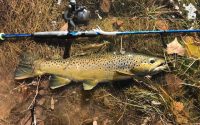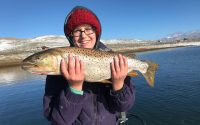Ice Fishing Is A Family Affair

Now that winter has finally arrived, more and more ice fishing opportunities will be available across northern Utah. Having been primed (after reading my two previous columns) to be safe and secure when on the ice, the only thing missing is a plan to get out and go fishing.
A few weeks ago, my wife Jeri and I spent a couple of fantastic days in northeastern Utah on several popular lakes. In most years, these lakes are only accessible by snowmobile in January, but we were able to get there without putting the truck into four-wheel drive. Of course, with the recent weekend snow storm, ice fishing conditions are changing (to the better) with each passing day, so choose a lake or reservoir over 7500 feet in elevation, ask around and you should be safe to give it a try.
Tips for a Successful Family Ice Fishing Trip
The challenge when taking the family ice fishing is to know their tolerance to the cold, ice conditions, and patience. Let’s take a look at the keys to a successful “family” adventure.
1. Plan ahead and know exactly what you’ll be facing on your chosen lake. For example, if you know there will be some slush on top of the ice, plan on a morning rather than afternoon trip. You could be off the ice before the need for waterproof boots to keep your feet dry.
2. Take a shelter if wind is in the forecast. Few things ruin a good fishing trip quickly than blowing snow without a place to hide.
3. When taking younger children along, have plenty of treats on hand, and be prepared for them to lose interest in the actual fishing, especially if the catching is slow. One of the best ways to help a youngster learn to enjoy the sport is to take a long a device such as a “Hi-Jacker,” that sets the hook so the youngster only has to pick up the rod and reel in the fish.
4. Stay on the ice for a maximum of three hours, regardless of how many fish you catch. Exposure is a real issue, especially with children or even spouses. If your family is not used to being in super bright, cold, and windy conditions, error on the side of caution and don’t stay too long. Repeat trips are much easier when your family doesn’t think they will be on the ice from dawn until dusk.
5. Do your homework. Know what baits and lures to bring, how to rig your rods, and how deep the fish have been active. If none of that is possible, drill at least three “test” holes starting in 10, 15, and 20 feet of water. Once fish are located, drill more holes in the active area. And, remember to stay at one of those first three holes for at least one hour before moving on.
Ice Fishing Can Be Fun
To get back to the story of my wife, Jeri, and her first time with me on the ice this winter, I knew we needed to be close to the truck. Bathroom breaks are important, and there are few things worse than being a mile off shore and your wife needs a break.
Then, I left Jeri in the truck while I set up our gear, drilled our first holes and actually targeted and caught our first fish. Since I was within earshot of the vehicle, I called to her, she joined me on the ice and almost instantly began catching fish. “This is so much fun,” she said after setting the hook and landing a beautiful 14-inch rainbow.
Over the years, all of our children have spent time on the ice. And, to a person, each can tell stories of ice fishing adventures that were too long, too cold, and the catching was too slow. But, as parents and grandparents hopefully learn, if the family has a great time, stay warm, can eat something, and catch a few fish, they will want to make yearly ice fishing trips a “family affair.”










